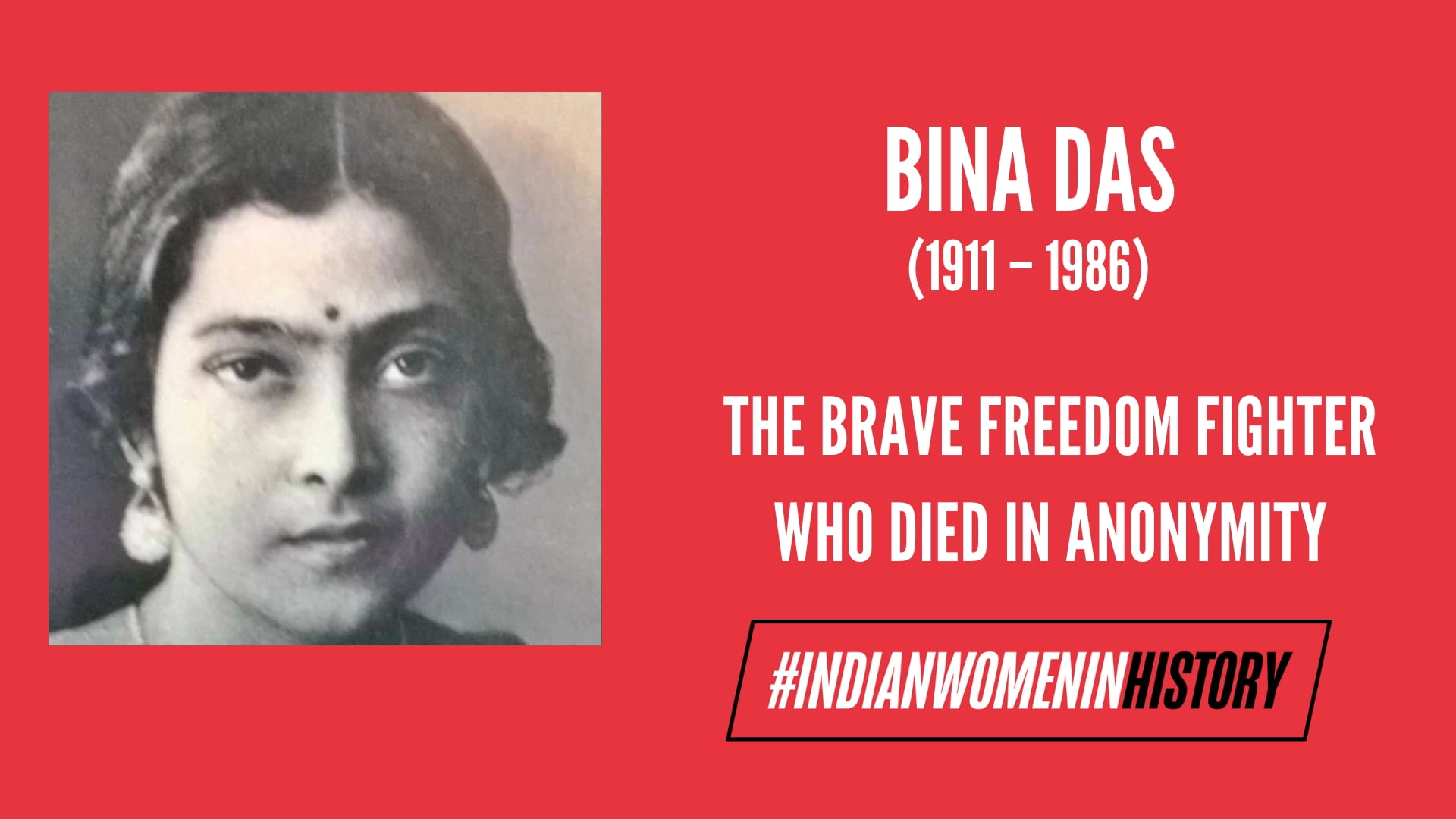This article is a part of the #IndianWomenInHistory campaign for Women’s History Month to remember the untold legacies of women who shaped India, especially India’s various feminist movements. One Indian woman is profiled each day for the whole of March 2019.
“Is life worth living in an India so much subjected to wrongs and continually groaning under the tyranny of a foreign Government or is it not better to make one supreme protest against it by offering one’s life away? ”
A decomposed body was found at a roadside in Rishikesh on the 26th of December in 1986. It took a whole month to identify the body – it belonged to one Bina Das. The piteous circumstances of this woman’s death – “unknown, unwept and unsung” – are cruelly ironic, given her political and moral commitment to the freedom struggle that gave birth to our nation. Even the Wikipedia page which is dedicated to her is relatively barren. Since it’s women’s history month, I want to honour her legacy by writing a fuller account of the person she was.
Revolutionary Beginnings
Bina Das’ family comprised of revolutionaries, of one kind or the other. Bina’s mother, Sarala Devi, established a hostel dedicated to the freedom struggle. Bombs were stored and distributed amongst its members. Bina’s father, Beni Madhab Das, was a well-known Brahmo teacher. Brahmo was a movement which aimed to reform Hindu practices, stressing on the importance of reason, based on influences from monotheistic religions and modern science. Bina’s older sister, Kalyani Das, was also a freedom fighter herself.
Bina shot two bullets at Stanley Jackson, the Governor of Bengal.
It was unsurprising that Bina too inherited the revolutionary instinct from her family. Regardless, Bina cultivated her sense of political righteousness independently, by joining the Chhatri Sangha (Women Students Association) upon the completion of her secondary school education. Chhatri Sangha played the role of equipping women who were dedicated to the cause of India’s independence with skills to become revolutionary figures. It arranged study groups through which the women were taught everything “lathi and swordplay to cycling and motor driving.”
The Assassination Attempt
On the 6th of February in 1932, Bina Das walked into the convocation hall of her ‘sacred alma mater’ with five bullets loaded onto a revolver, hidden under her skirt. She was prepared to assassinate the Bengal Governor Stanley Jackson as an act of defiance against the British Raj. However, the attempt was unsuccessful.
Using an excuse, Bina came close to the stage where Stanley Jackson was delivering his speech. She shot two bullets. He dodged both. The Vice Chancellor leapt to shield him by overpowering Bina. Even as she was being overpowered, she fired three shots. Stanley Jackson’s ear was grazed by one of the bullets, but he was otherwise unharmed.
Bina made the
The Trial
It is hard to imagine how a failed attempt at assassinating a member of the British Raj by a ‘fragile-looking’ 21-year-old woman could play such a profound role in the expansive struggle to free India. I believe that the gravitas of Bina Das’ revolutionary impact lies in the statement she provided the Calcutta High Court after the attempted assassination.
It was more than a confession to a crime. It was an insight into the mind of a woman who took an action despite it being “
Her religious beliefs and morality were tied to the desire for political freedom.
Even though she stood in front of the Calcutta High Court
In her statement, Bina made an interesting distinction between Stanley Jackson as a person and Stanley Jackson as a Governor. Her grudge was never personal, and she claimed she would have opened fire on any person who was stood on the podium and held the title of Governor of Bengal. Her action was a symbol of the protest against the British colonial system, which “has kept enslaved 300 million of my countrymen and countrywomen.”
Also read: Kasturba Gandhi: The Lesser Known Freedom Fighter | #IndianWomenInHistory
I could go on and on about the profundity of her statement, but one must read it themselves to get a real sense of who Bina Das was.
Her memoir, translated by Dhira Dhar, was published by Zubaan Books. In addition to this, Kalyani Bhattacharjee (her sister) edited a book called Bengal Speaks (published in 1944) and dedicated it to her.
Continued Activism
Bina continued her activism after her nine-year sentencing, until Independence in 1947. In 1960, she received the Padma Shri award for “social work”. A grave misnomer, one might say.
After the death of her husband, a fellow freedom fighter, she retreated from public scrutiny to Rishikesh. She had spent her life refusing every pension payment that the government provided to freedom fighters.
Also read: Kanaklata Barua: The Forgotten Teen Freedom Fighter | #IndianWomenInHistory
She died in solitude and anonymity, but her contributions to the struggle for Indian independence will be remembered. Hopefully, she will be granted her space in mainstream narratives of the freedom struggle and in the history books, and not just in unconventional internet sources.
References
1. The Better India
2. Zubaan Books
3. World Cat
4. India Of The Past
About the author(s)
Richa is talkative, argumentative but, above all, loves all things feminism.




